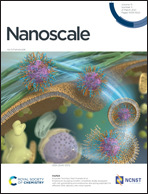Quasi-static 3D structure of graphene ripple measured using aberration-corrected TEM†
Abstract
Free-standing graphene has a three-dimensional (3D) structure, called a ripple, rather than a perfect two-dimensional (2D) crystal. Since theoretical calculations suggest that a ripple strongly influences various fundamental physicochemical properties of graphene, it is important to clarify the ripple structure quantitatively in experiments. This paper proposes a new method of measuring the 3D atomic structure of a ripple by using aberration-corrected transmission electron microscopy (TEM). The method utilizes the fact that the 2D contrast of a TEM image is sensitive to the height of a six-membered ring. The proposed method is experimentally applied to a monolayer graphene, and the 3D atomic arrangements of consecutively acquired TEM images are reconstructed. In that experiment, the specimen is found to be moving upward. Furthermore, the atomic arrangement can be approximated as a composite of two structures consisting of a 3D ripple and a 2D plane. The ripple is represented as a superposition of sinusoidal waves, with their wave vectors coinciding with the specific direction of the six-membered ring. The time dependences of the height and lateral size of the ripple are also measured.



 Please wait while we load your content...
Please wait while we load your content...